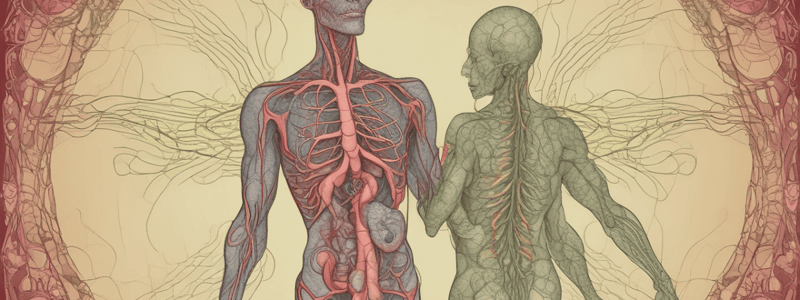Podcast
Questions and Answers
What is the primary function of the lymphatic system in relation to fluid balance?
What is the primary function of the lymphatic system in relation to fluid balance?
- To collect excess fluid and proteins from the interstitial spaces and return them to the bloodstream (correct)
- To remove excess fluid from the bloodstream
- To regulate blood pressure
- To distribute nutrients to tissues
Which of the following organs is responsible for containing lymphoid tissue in the lymphatic system?
Which of the following organs is responsible for containing lymphoid tissue in the lymphatic system?
- Liver
- Pancreas
- Lymph nodes (correct)
- Kidneys
What is the process by which water molecules move from an area of high water concentration to an area of low water concentration?
What is the process by which water molecules move from an area of high water concentration to an area of low water concentration?
- Osmosis (correct)
- Diffusion
- Active transport
- Passive transport
What is the result of an imbalance in the lymphatic system's ability to regulate fluid balance?
What is the result of an imbalance in the lymphatic system's ability to regulate fluid balance?
Which of the following structures is responsible for transporting lymph from peripheral tissues to the veins of the cardiovascular system?
Which of the following structures is responsible for transporting lymph from peripheral tissues to the veins of the cardiovascular system?
What is the primary reason why water molecules move from the blood into the interstitial spaces in the context of the lymphatic system?
What is the primary reason why water molecules move from the blood into the interstitial spaces in the context of the lymphatic system?
What is the primary function of the lymphatic system in relation to the blood circulation system?
What is the primary function of the lymphatic system in relation to the blood circulation system?
What is the name of the condition characterized by the accumulation of excess interstitial fluid in tissues?
What is the name of the condition characterized by the accumulation of excess interstitial fluid in tissues?
What is the role of lymphatic capillaries in the lymphatic system?
What is the role of lymphatic capillaries in the lymphatic system?
What is the consequence of disruptions in the lymphatic system?
What is the consequence of disruptions in the lymphatic system?
What is the location of interstitial fluid in the body?
What is the location of interstitial fluid in the body?
What is the relationship between the lymphatic system and the blood circulation system?
What is the relationship between the lymphatic system and the blood circulation system?
Study Notes
The lymphatic system is an essential component of the circulatory system, responsible for maintaining fluid balance, aiding in the absorption of fats and fat-soluble vitamins, and serving as part of the immune system. It operates in parallel to the blood circulatory system, collecting excess fluid and proteins from the interstitial spaces and returning them to the bloodstream.
Lymphatic System
The lymphatic system consists of lymph vessels, which transport lymph from peripheral tissues to the veins of the cardiovascular system, and organs that contain lymphoid tissue, such as lymph nodes, the spleen, and the thymus. Lymph vessels have a structure similar to veins, with one-way valves to prevent backflow. They grow progressively larger and form two major lymphatic ducts: the right lymphatic duct, which drains the upper right quadrant, and the thoracic duct, which drains the remaining lymphatic tributaries.
Osmosis
Osmosis is a passive process by which water molecules move from an area of high water concentration to an area of low water concentration. In the context of the lymphatic system, it occurs when water moves from the blood into the interstitial spaces due to the presence of proteins and other solutes that attract water molecules. This process is essential for maintaining fluid balance and providing nutrients to tissues.
Blood Circulation
The blood circulation system, consisting of the heart, blood vessels, and blood, works in conjunction with the lymphatic system to maintain overall fluid balance. The heart pumps blood through the circulatory system, delivering oxygen and nutrients to tissues. Some fluid leaks out of the blood capillaries into the interstitial spaces, where it is picked up by the lymphatic system for return to the bloodstream.
Interstitial Fluid
Interstitial fluid is the fluid that fills the space between cells in the body. It is present in the interstitial spaces of all tissues and is an essential component of the lymphatic system's function. Lymphatic capillaries, which have thin endothelial walls and are arranged in an overlapping pattern, allow fluid to enter the capillary from the interstitial spaces.
Edema Regulation
Edema is the accumulation of excess interstitial fluid in tissues, leading to swelling. The lymphatic system plays a crucial role in regulating edema by collecting excess fluid and returning it to the bloodstream. Disruptions in the lymphatic system, such as damage to collecting lymphatic vessels or obstruction of lymphatic ducts, can lead to incurable swelling of tissues called lymphedema.
In summary, the lymphatic system is a vital component of the circulatory system, responsible for maintaining fluid balance, aiding in the absorption of fats and fat-soluble vitamins, and serving as part of the immune system. It operates in parallel to the blood circulatory system, collecting excess fluid and proteins from the interstitial spaces and returning them to the bloodstream. The lymphatic system's performance is robust, but disruptions can lead to edema and other serious conditions.
Studying That Suits You
Use AI to generate personalized quizzes and flashcards to suit your learning preferences.
Description
Learn about the lymphatic system, its components, and functions, including maintaining fluid balance, aiding in nutrient absorption, and serving as part of the immune system. Understand how it operates in parallel with the blood circulatory system and its role in regulating edema.




